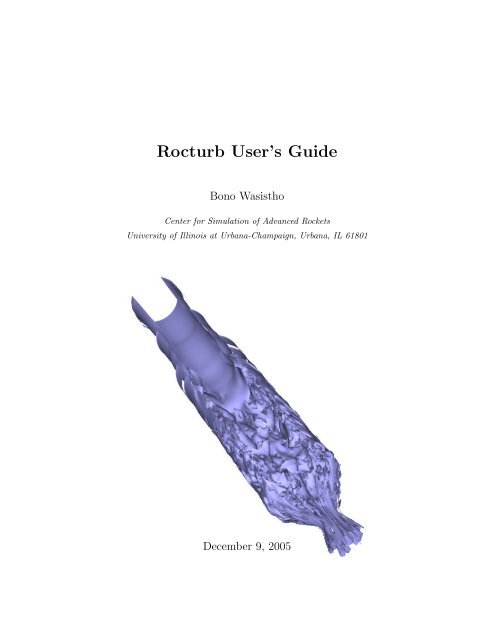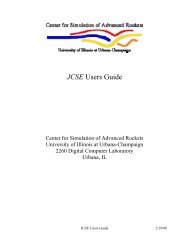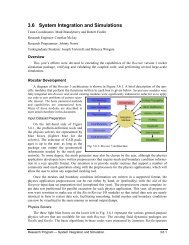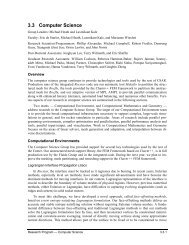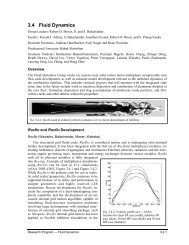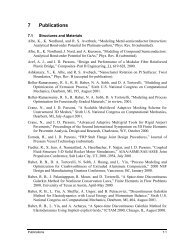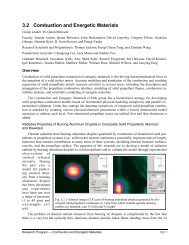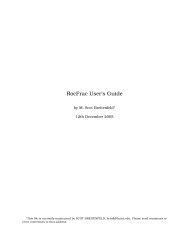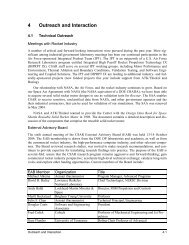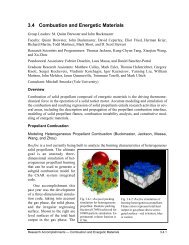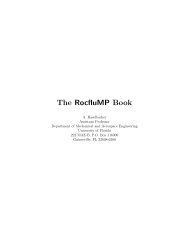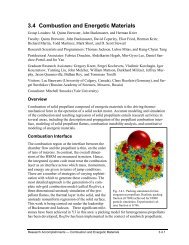Rocturb User's Guide - Center for Simulation of Advanced Rockets
Rocturb User's Guide - Center for Simulation of Advanced Rockets
Rocturb User's Guide - Center for Simulation of Advanced Rockets
You also want an ePaper? Increase the reach of your titles
YUMPU automatically turns print PDFs into web optimized ePapers that Google loves.
<strong>Rocturb</strong> User’s <strong>Guide</strong><br />
Bono Wasistho<br />
<strong>Center</strong> <strong>for</strong> <strong>Simulation</strong> <strong>of</strong> <strong>Advanced</strong> <strong>Rockets</strong><br />
University <strong>of</strong> Illinois at Urbana-Champaign, Urbana, IL 61801<br />
December 9, 2005
2<br />
Title:<br />
ROCTURB User’s <strong>Guide</strong><br />
Author:<br />
Bono Wasistho (research scientist)<br />
Subject:<br />
<strong>Guide</strong> <strong>for</strong> using turbulence and statistics<br />
module in Rocfluid MP<br />
Revision: 1<br />
Revision history:<br />
Revision 0: User’s guide <strong>for</strong> old Rocflo code<br />
Revision 1: User’s guide <strong>for</strong> Rocfluid MP and Rocstar2.5 code<br />
Revision 2: User’s guide <strong>for</strong> current Rocfluid MP and Rocstar3 code<br />
Effective date: 12/12/2005
Contents<br />
1 Introduction 5<br />
1.1 Objectives . . . . . . . . . . . . . . . . . . . . . . . . . . . . . . . . . . . . . 5<br />
1.2 Model Classes and Application Regimes . . . . . . . . . . . . . . . . . . . . 5<br />
1.3 Reference Models Implemented . . . . . . . . . . . . . . . . . . . . . . . . . 5<br />
1.4 Building and Running . . . . . . . . . . . . . . . . . . . . . . . . . . . . . . 6<br />
2 <strong>Rocturb</strong> I/O Files 7<br />
2.1 Input Files . . . . . . . . . . . . . . . . . . . . . . . . . . . . . . . . . . . . . 7<br />
2.1.1 [CaseName].inp file . . . . . . . . . . . . . . . . . . . . . . . . . . . . 7<br />
2.1.2 Cautions . . . . . . . . . . . . . . . . . . . . . . . . . . . . . . . . . . 7<br />
2.1.3 Interdependency <strong>of</strong> input parameters . . . . . . . . . . . . . . . . . . 8<br />
2.2 Output Files . . . . . . . . . . . . . . . . . . . . . . . . . . . . . . . . . . . . 8<br />
3 Wall Layer Model and Statistics I/O Files 10<br />
3.1 Wall Layer Model . . . . . . . . . . . . . . . . . . . . . . . . . . . . . . . . . 10<br />
3.1.1 [CaseName].bc file . . . . . . . . . . . . . . . . . . . . . . . . . . . . 10<br />
3.2 Statistics I/O Files . . . . . . . . . . . . . . . . . . . . . . . . . . . . . . . . 10<br />
3.2.1 [CaseName].inp file . . . . . . . . . . . . . . . . . . . . . . . . . . . . 10<br />
3.2.2 [CaseName].stata/statb file . . . . . . . . . . . . . . . . . . . . . . . 11<br />
4 Examples and Test Problems 12<br />
4.1 Blasius Test Case . . . . . . . . . . . . . . . . . . . . . . . . . . . . . . . . . 12<br />
4.1.1 blasius.inp file . . . . . . . . . . . . . . . . . . . . . . . . . . . . . . . 12<br />
4.1.2 blasius.top file <strong>for</strong> single processor run . . . . . . . . . . . . . . . . . 14<br />
4.1.3 blasius.top file <strong>for</strong> multi processors run . . . . . . . . . . . . . . . . . 15<br />
4.1.4 Comparison result <strong>of</strong> Blasius case . . . . . . . . . . . . . . . . . . . . 15<br />
5 <strong>Rocturb</strong> Verification and Validation 16<br />
5.1 Analytical Field . . . . . . . . . . . . . . . . . . . . . . . . . . . . . . . . . . 16<br />
5.2 Compressible Periodic Rocket (CPR) . . . . . . . . . . . . . . . . . . . . . . 17<br />
5.2.1 Laminar . . . . . . . . . . . . . . . . . . . . . . . . . . . . . . . . . . 17<br />
5.2.2 Turbulent . . . . . . . . . . . . . . . . . . . . . . . . . . . . . . . . . 19<br />
5.3 Turbulent Channel Flow at Various Reynolds Numbers . . . . . . . . . . . . 20<br />
3
4 Contents<br />
5.4 Papers on <strong>Rocturb</strong> Verification and Validation . . . . . . . . . . . . . . . . . 21
Chapter 1<br />
Introduction<br />
1.1 Objectives<br />
For computations involving turbulence, direct simulations <strong>of</strong> pure 3D Navier-Stokes equations<br />
in RocfloMP would in many cases be prohibitive due to high resolution requirement.<br />
This requirement can be substantially eased with the help <strong>of</strong> turbulence model because the<br />
small scale fluctuations do not have to be resolved, instead they are modeled in terms <strong>of</strong> the<br />
resolved scales on a coarser grid. This <strong>Rocturb</strong> module is there<strong>for</strong>e developed in order to<br />
provide users with various turbulence models to suit their flow features.<br />
1.2 Model Classes and Application Regimes<br />
We <strong>of</strong>fer users three different classes <strong>of</strong> turbulence models: full LES (Large Eddy <strong>Simulation</strong>),<br />
RANS (Reynolds Averaged Navier Stokes) and Hybrid model, i.e. LES with near wall<br />
model. The near wall model can be based on Rans or turbulent boundary layer pr<strong>of</strong>iles<br />
in equilibrium or non-equilibrium, depending on the flow pressure gradient. For turbulent<br />
flows with thin wall shear layer, one can use LES with wall model, or DES (Detached Eddy<br />
<strong>Simulation</strong>) where the inner and outer layer is more tightly coupled. For a highly unsteady<br />
large structure motions away from the wall, such as in wall injection flows, it is recommended<br />
to use full LES as the wall requirement is less stringent, while <strong>for</strong> high Reynolds number<br />
flows with weak unsteadiness in the mean and if the interest is mainly on the mean flow,<br />
Rans is more suitable due to the less demanding grid requirement. If desired, DES can be<br />
used <strong>for</strong> high Reynolds number flow as well. DES is especially suitable <strong>for</strong> flows involving<br />
massive separation.<br />
1.3 Reference Models Implemented<br />
A) LES class:<br />
1) basic Smagorinsky (Smagorinsky 1963),<br />
5
6 Chapter 1. Introduction<br />
2) scale-similarity (Bardina et al. 1984),<br />
3) dynamic Smagorinsky (Germano et al. 1991 and Germano 1992),<br />
4) dynamic mixed (Zang et al. 1993 and Vreman et al. 1994).<br />
B) RaNS class:<br />
1) SA (Spalart & Allmaras 1994),<br />
2) k − ɛ (Jones & Launder 1972 and Launder & Sharma 1974).<br />
C) Hybrid class:<br />
1) DES (Dettached Eddy <strong>Simulation</strong>) (Nikitin et al. 2000),<br />
2) Non-equilibrium wall layer model <strong>for</strong> LES (developed by Wasistho).<br />
It is possible to select different models in different zones (zonal modeling). For instance, one<br />
can compute LES using a dynamic model in the propellant chamber, but employing the fixed<br />
Smagorinsky model in the nozzle to provide more damping along the thin boundary layer<br />
(fixed Smagorinsky without Van Driest damping provides finite, non-zero eddy viscosity at<br />
the wall)<br />
1.4 Building and Running<br />
To include turbulence module when creating the executable, user has to compile and link<br />
subroutines in directory rocturb. This is done automatically by adding option ROCTURB=1<br />
after the compilation command gmake or make in the main directory RocfluidMP. To activate<br />
statistics module add STATS=1. As example, to compile with the structured grid code,<br />
one can choose following option: ’gmake RFLO=1 TURB=1 STATS=1 MPI=1’. The executable,<br />
i.e. rflomp <strong>for</strong> RFLO or rflump <strong>for</strong> RFLU, is then created in directory RocfluidMP.<br />
The sample input files as outlined below in Chapter Examples and Test Problems can be<br />
found in directory Rocstar/RocfluidMP/Data/. A brief explanation <strong>of</strong> regarding each input<br />
parameter and what the user is expected to enter is provided at the right hand side.
Chapter 2<br />
<strong>Rocturb</strong> I/O Files<br />
2.1 Input Files<br />
2.1.1 [CaseName].inp file<br />
# TURBULENCE<br />
BLOCK 0 0 ! applies to block ... (0 0 = to all)<br />
TURBMODEL 0 ! 0=laminar 1=FixSmag 2=ScalSim 3=DynSmag 4=DynMixed<br />
! 5=RaNS-SA 6=DES-SA<br />
OUTPUTNUMBER 1 ! number <strong>of</strong> output fields 1=mut, 2=1+tvort, 3=2+length-scl<br />
! if TURBMODEL = 1-4 (LES)<br />
CSMAGORINSKY 0.10 ! Model constant, only relevant <strong>for</strong> TURBMODEL=1<br />
FILTERTYPE 0 ! 0=uni<strong>for</strong>m, 1=non-uni<strong>for</strong>m<br />
DELTATYPE 0 ! 0=cuberoot-<strong>for</strong>mula, 1=squareroot-<strong>for</strong>mula<br />
IFILTERWIDTH 1 ! filterwidth in I-direction/grid-spacing<br />
JFILTERWIDTH 1 ! filterwidth in J-direction/grid-spacing<br />
KFILTERWIDTH 1 ! filterwidth in K-direction/grid-spacing<br />
IHOMOGENDIR 0 ! 0=non-homogeneous, 1=homogeneous I-direction<br />
JHOMOGENDIR 0 ! 0=non-homogeneous, 1=homogeneous J-direction<br />
KHOMOGENDIR 0 ! 0=non-homogeneous, 1=homogeneous K-direction<br />
ENERGYMODEL 1 ! 0=OFF, 1=ACTIVE energy subgrid model<br />
CALCVORTIC 0 ! 0 NO, 1 per fluid-dt, 2 per system-dt<br />
! if TURBMODEL >= 5 (RANS or DES)<br />
WALLDISTMETHOD 0 ! wall distance calc.method: 0 direct, 1 step-wise, 2 PDE<br />
WALLDISTFREQ 0 ! 0 only initial, 1 per-remesh, 2 system-dt, 3 fluid-dt<br />
VISCFUNCTION 0 ! viscous function, SA (fv1): 0= power 3, 1= power 2<br />
CDES<br />
0.65 ! DES lengthscale coefficient<br />
SMOOCF 0.7 ! coeff. <strong>of</strong> implicit res.smoothing (
8 Chapter 2. <strong>Rocturb</strong> I/O Files<br />
assumed to be homogeneous and the grid in this direction to be uni<strong>for</strong>m. Should there<br />
be any change in (i,j,k) orientation between regions, the user should cycle the values<br />
<strong>of</strong> I,J,KHOMOGENDIR and I,J,KFILTERWIDTH accordingly.<br />
• ENERGYMODEL. When this parameter is active (1), the current implementation<br />
requires that the turbulence model should have a non-zero value in every region, otherwise<br />
an error message will prompt. If user needs to activate turbulence model only<br />
in certain regions, then ENERGYMODEL should be turned <strong>of</strong>f. This limitation will<br />
be removed in the future (by defining an MPI communicator specific <strong>for</strong> rocturb).<br />
2.1.3 Interdependency <strong>of</strong> input parameters<br />
The interdependency <strong>of</strong> input parameters in the .inp file is described in the table<br />
FLOWTYPE TURBMODEL FILTERWIDTH<br />
TURBMODEL NS steady and unsteady 1-6<br />
CSMAGORINSKY NS unsteady 1<br />
FILTERTYPE NS unsteady 2-4 =/=(0,0,0)<br />
DELTATYPE NS unsteady 2-4 =/=(0,0,0)<br />
FILTERWIDTH NS unsteady 2-4 =/=(0,0,0)<br />
HOMOGENDIR NS unsteady 3-4 =/=(0,0,0)<br />
ENERGYMODEL NS unsteady 1-4 =/=(0,0,0)<br />
CALCVORTIC NS unsteady 1-6<br />
WALLDISTMETHOD NS steady and unsteady 5-6<br />
WALLDISTFREQ NS unsteady 5-6<br />
VISCFUNCTION NS steady and unsteady 5-6<br />
CDES NS unsteady 6<br />
SMOOCF NS steady and unsteady 5-6<br />
DISCR NS steady and unsteady 5-6<br />
K2 NS steady and unsteady 5-6<br />
1/K4 NS steady and unsteady 5-6<br />
ORDER NS steady and unsteady 5-6<br />
Table 2.1: Interdependency <strong>of</strong> input parameters in the .inp file.<br />
2.2 Output Files<br />
The output file <strong>for</strong> instantaneous turbulent (LES, DES, URANS) and steady state turbulent<br />
(RANS) quantities is the .turba file <strong>for</strong> ASCII <strong>for</strong>mat or the .turbb file <strong>for</strong> binary <strong>for</strong>mat.<br />
These files may contain 1 up to 3 fields, depending on the parameter OUTPUTNUMBER.<br />
Value 1 (default) will give only eddy viscosity field, 2 vorticity field is added, 3 length scale<br />
<strong>of</strong> turbulence model is added (3 is only <strong>for</strong> RaNS and DES). Eddy viscosity will always
2.2. Output Files 9<br />
be output since it is needed <strong>for</strong> exact restart from the use <strong>of</strong> µ t in the viscous time step<br />
computation. Statistics <strong>of</strong> turbulence is output in the .stata (ASCII) or .statb (binary). The<br />
statistics variables are described in Chapter 3.
Chapter 3<br />
Wall Layer Model and Statistics I/O<br />
Files<br />
3.1 Wall Layer Model<br />
There is no output file specific <strong>for</strong> wlm quantities.<br />
3.1.1 [CaseName].bc file<br />
Boundary condition (.bc) file:<br />
# BC_WALLMODEL<br />
BLOCK 0 0 ! applies to block ... (0 0 = to all)<br />
PATCH 0 0 ! applies to patch ... (0 0 = to all patches from above range <strong>of</strong> blocks)<br />
MODEL 2 ! 0=nomodel 1=loglay 2=bndlay 3=external (feed tau_w distribution)<br />
REFPOINT 1 ! reference point (1 to max. wall normal points in the block)<br />
ROUGHNESS 0.0001 ! roughness size [meter]<br />
#<br />
3.2 Statistics I/O Files<br />
3.2.1 [CaseName].inp file<br />
# STATISTICS<br />
DOSTAT 1 ! 1=ON, 0=OFF<br />
RESTART 0 ! restart switch: 1 = continued process, 0 = new process<br />
MIXTNSTAT 11 ! number <strong>of</strong> mixture statistics with their ID’s below<br />
MIXTSTATID 01 02 03 04 06 11 22 33 44 23 66<br />
! 1=rho 2=u 3=v 4=w 5=T 6=p 7=vsound 8=muel 9=tcol 22=uu etc<br />
TURBNSTAT 2 ! number <strong>of</strong> mixture statistics with their ID’s below<br />
TURBSTATID 01 03<br />
! 1=muet 2=tcot 3=cdyn 4:7=t11,t22,t33,t12 8=mmij 9=mlij<br />
PLAGNSTAT 10<br />
PLAGSTATID 01 02 03 04 05 06 07 08 09 44<br />
! 1=diam3 2=diam4 3=numDens 4=u 5=v 6=w 7=mass 8=compAl<br />
! 9=compAl2O3 44=uu
3.2. Statistics I/O Files 11<br />
#<br />
3.2.2 [CaseName].stata/statb file<br />
time, ∆T<br />
MIXTNSTAT MIXTSTATID(1:MIXTNSTAT)<br />
TURBNSTAT TURBSTATID(1:TURBNSTAT)<br />
IREGION ni nj nk ndum<br />
((F mixt (l,ijk), ijk = ijkBeg,ijkEnd), l = 1,NSTAT)<br />
((F turb (l,ijk), ijk = ijkBeg,ijkEnd), l = 1,TURBNSTAT)
Chapter 4<br />
Examples and Test Problems<br />
4.1 Blasius Test Case<br />
4.1.1 blasius.inp file<br />
! Input file <strong>for</strong> blasius case<br />
! mapping <strong>of</strong> blocks to processors ----------------------------------------------<br />
# BLOCKMAP<br />
NBLOCKS 0 ! no. <strong>of</strong> blocks per processor (0=automatic mapping)<br />
#<br />
! grid/solution <strong>for</strong>mat ---------------------------------------------------------<br />
# FORMATS<br />
GRID 0 ! 0=Plot3D ASCII, 1=Plot3D binary, 2=HDF<br />
SOLUTION 0 ! 0=ASCII, 1=binary, 2=HDF<br />
#<br />
! viscous/inviscid flow --------------------------------------------------------<br />
# FLOWMODEL<br />
BLOCK 0 0 ! applies to block ... (0 0 = to all)<br />
MODEL 1 ! 0=inviscid (Euler), 1=viscous (Navier-Stokes)<br />
MOVEGRID 0 ! moving grid (0=no, 1=yes)<br />
#<br />
! reference values -------------------------------------------------------------<br />
# REFERENCE<br />
ABSVEL 170.1432 ! absolute velocity [m/s]<br />
PRESS 1.E+5 ! static pressure [Pa]<br />
DENS 1.209 ! density [kg/m^3]<br />
CP 1004.5 ! specific heat coeff. at constant pressure [J/kgK]<br />
GAMMA 1.4 ! ratio <strong>of</strong> specific heats<br />
LENGTH 0.00529 ! length [m]<br />
RENUM 62500.0 ! Reynolds number (lam. viscosity = dens*absvel*length/renum)<br />
PRLAM 0.72 ! laminar Prandtl number<br />
PRTURB 0.9 ! turbulent Prandtl number<br />
SCNLAM 0.22 ! laminar Schmidt number<br />
SCNTURB 0.9 ! turbulent Schmidt number<br />
#
4.1. Blasius Test Case 13<br />
! probe ------------------------------------------------------------------------<br />
# PROBE<br />
NUMBER 1<br />
1 1 10 10 ! block, icell, jcell, kcell (1=first physical cell)<br />
2 1 40 10<br />
#<br />
! <strong>for</strong>ces -----------------------------------------------------------------------<br />
# FORCES<br />
TYPE 0 ! 0=no <strong>for</strong>ces calculated, 1=pressure <strong>for</strong>ces, 2=1+viscous <strong>for</strong>ces<br />
#<br />
! multi-physics modules: -------------------------------------------------------<br />
# TURBULENCE<br />
BLOCK 1 1 ! applies to block ... (0 0 = to all)<br />
TURBMODEL 3 ! 0=laminar, 1=Smag., 2=ScalSim, 3=DynSmag., 4=DynMix, etc.<br />
CSMAGORINSKY 0.05<br />
FILTERTYPE 0<br />
DELTATYPE 0<br />
IFILTERWIDTH 1<br />
JFILTERWIDTH 1<br />
KFILTERWIDTH 1<br />
IHOMOGENDIR 0<br />
JHOMOGENDIR 0<br />
KHOMOGENDIR 0<br />
ENERGYMODEL 1<br />
#<br />
# TURBULENCE<br />
BLOCK 2 2 ! applies to block ... (0 0 = to all)<br />
TURBMODEL 3 ! 0=laminar, 1=Smag., 2=ScalSim, 3=DynSmag., 4=DynMix, etc.<br />
CSMAGORINSKY 0.05<br />
FILTERTYPE 0<br />
DELTATYPE 0<br />
IFILTERWIDTH 1<br />
JFILTERWIDTH 1<br />
KFILTERWIDTH 1<br />
IHOMOGENDIR 0<br />
JHOMOGENDIR 0<br />
KHOMOGENDIR 0<br />
ENERGYMODEL 1<br />
#<br />
# SPECIES<br />
BLOCK 0 0 ! applies to block ... (0 0 = to all)<br />
MODEL 0 ! 0=perfect gas, 1=...<br />
#<br />
# CONPART<br />
BLOCK 0 0 ! applies to block ... (0 0 = to all)<br />
USED 0 ! 0=module not used<br />
#<br />
# DISPART<br />
BLOCK 0 0 ! applies to block ... (0 0 = to all)<br />
USED 0 ! 0=module not used<br />
#<br />
# RADIATION<br />
BLOCK 0 0 ! applies to block ... (0 0 = to all)<br />
USED 0 ! 0=module not used
14 Chapter 4. Examples and Test Problems<br />
#<br />
! time-stepping control --------------------------------------------------------<br />
# TIMESTEP<br />
FLOWTYPE 1 ! 0=steady flow, 1=unsteady flow<br />
! if FLOWTYPE=0<br />
TIMESTEP 5.E-8 ! max. physical time step [s]<br />
STARTTIME 2.E-7 ! current time<br />
MAXTIME 4.E-7 ! max. time simulated [s]<br />
WRITIME 1.E-5 ! time <strong>of</strong>fset [s] to store solution<br />
PRNTIME 5.E-8 ! time <strong>of</strong>fset [s] to print convergence<br />
! if FLOWTYPE=0<br />
STARTITER 0 ! current iteration<br />
MAXITER 20 ! max. number <strong>of</strong> iterations<br />
RESTOL 1.E-5 ! max. density residual to stop iterations<br />
WRIITER 1000 ! <strong>of</strong>fset between iterations to store solution<br />
PRNITER 2 ! <strong>of</strong>fset between iterations to print convergence<br />
#<br />
! time averaged statistics <strong>for</strong> unsteady flow -----------------------------------<br />
# STATISTICS<br />
DOSTAT 0 ! 1=ON, 0=OFF<br />
RESTART 1 ! restart switch: 1 = continued process, 0 = new process<br />
MIXTNSTAT 6 ! number <strong>of</strong> MIXT statistics variables with their ID’s below<br />
MIXTSTATID 01 02 03 04 05 33 34<br />
! 1=rho,2=u,3=v,4=w,5=T,6=p,7=vsound,8=muel,9=tcol,22=uu,etc<br />
TURBNSTAT 2 ! number <strong>of</strong> TURB statistics variables with their ID’s below<br />
TURBSTATID 01 03<br />
! 1=muet, 2=tcot, 3=cdyn<br />
#<br />
! numerics ---------------------------------------------------------------------<br />
# MULTIGRID<br />
START 1 ! at which grid level to start (>0; 1=finest grid)<br />
CYCLE 0 ! 0=no MG, 1=V-cycle, 2=W-cycle<br />
REFINE 99999 ! no. <strong>of</strong> iterations be<strong>for</strong>e switching to next finer grid<br />
#<br />
# NUMERICS<br />
BLOCK 0 0 ! applies to block ... (0 0 = to all)<br />
CFL 7.0 ! CFL number<br />
SMOOCF 0.7 ! coefficient <strong>of</strong> implicit residual smoothing (
4.1. Blasius Test Case 15<br />
100 1 1 25 1 64 0 0 0 0 0 0 0<br />
100 2 1 25 1 64 0 0 0 0 0 0 0<br />
10 3 1 64 1 2 0 0 0 0 0 0 0<br />
20 4 1 64 1 2 0 0 0 0 0 0 0<br />
100 5 1 2 1 25 0 0 0 0 0 0 0<br />
60 6 1 2 1 25 0 0 0 0 0 0 0<br />
4.1.3 blasius.top file <strong>for</strong> multi processors run<br />
# topology file <strong>for</strong> Blasius flow - 2 blocks<br />
#<br />
2 ! total no. <strong>of</strong> blocks<br />
1 1 ! block, no. <strong>of</strong> grid levels<br />
6 2 25 64 ! no. <strong>of</strong> patches, icells, jcells, kcells<br />
100 1 1 25 1 64 0 0 0 0 0 0 0 ! type, lb, l1beg, l1end, l2beg, l2end<br />
100 2 1 25 1 64 0 0 0 0 0 0 0 ! coord. aligned<br />
10 3 1 64 1 2 0 0 0 0 0 0 0<br />
30 4 -1 -64 1 2 2 3 -1 -64 1 2 0<br />
60 5 1 2 1 25 0 0 0 0 0 0 0<br />
100 6 1 2 1 25 0 0 0 0 0 0 0<br />
2 1 ! block, no. <strong>of</strong> grid levels<br />
6 2 100 64 ! no. <strong>of</strong> patches, icells, jcells, kcells<br />
100 1 1 100 1 64 0 0 0 0 0 0 0<br />
100 2 1 100 1 64 0 0 0 0 0 0 0<br />
30 3 -1 -64 1 2 1 4 -1 -64 1 2 0<br />
20 4 1 64 1 2 0 0 0 0 0 0 0<br />
70 5 1 2 1 100 0 0 0 0 0 0 0<br />
100 6 1 2 1 100 0 0 0 0 0 0 0<br />
4.1.4 Comparison result <strong>of</strong> Blasius case<br />
Figure 5.1 shows comparison <strong>of</strong> compressible Blasius solution at Mach 0.5 between Rocflo<br />
(black) and analytical solution (blue). The two solution shows virtually perfect collapse.
Chapter 5<br />
<strong>Rocturb</strong> Verification and Validation<br />
5.1 Analytical Field<br />
The expression <strong>of</strong> a turbulence model applied on an analytical flow can be exactly derived.<br />
There<strong>for</strong>e an analytical flow is imposed as initial condition to check whether the turbulence<br />
model gives the correct result. This check is currently done <strong>for</strong> the Smagorinsky model (see<br />
<strong>Rocturb</strong> Developer’s guide <strong>for</strong> model description)<br />
µ t = ρC 2 s ∆ 2 |S|. (5.1)<br />
We consider an analytical flow which vary only in the x 1 direction first<br />
u 1 = sin 2x 1 (5.2)<br />
u 2 = cos 2x 1 (5.3)<br />
u 3 = 0. (5.4)<br />
It can easily be derived that the expression <strong>for</strong> the strain rate tensor magnitude is<br />
Defining the maximum error as<br />
|S| = 2(1 + 1 3 cos2 2x 1 ) 1 2 . (5.5)<br />
err max = max ( |µ t−analytic − µ t−R4.0 | )<br />
|µ t−analytic |<br />
(5.6)<br />
the maximum (discretization) error introduced by Rocflo-<strong>Rocturb</strong> as function <strong>of</strong> grid refinement<br />
in the x 1 direction with nj=32 and nk=2 is shown on the left hand side <strong>of</strong> table 5.1.<br />
Next we also check on an analytical flow which vary only in the x 2 direction first<br />
u 1 = sin 2x 2 (5.7)<br />
u 2 = cos 2x 2 (5.8)<br />
u 3 = 0. (5.9)
5.2. Compressible Periodic Rocket (CPR) 17<br />
ni err max nj err max<br />
32 1.6056069 E-3 32 6.4131489 E-3<br />
64 4.0154685 E-3 64 1.6056069 E-3<br />
128 1.0039578 E-4 128 4.0154685 E-3<br />
256 2.5099513 E-5 256 1.0039578 E-4<br />
512 6.2749139 E-6 512 2.5099513 E-5<br />
Table 5.1: Maximum errors <strong>for</strong> the x 1 (left) and x 2 (right) varying flow field<br />
The expression <strong>for</strong> the strain rate tensor magnitude is given by<br />
|S| = 2(1 + 1 3 sin2 2x 2 ) 1 2 . (5.10)<br />
The maximum (discretization) error introduced by Rocflo-<strong>Rocturb</strong> as function <strong>of</strong> grid refinement<br />
in the x 2 with ni=32 and nk=2 is shown on the right hand side <strong>of</strong> table 5.1. The<br />
test shows that the convergence rate with the grid refinement is <strong>of</strong> factor 4 which implies<br />
the second order accuracy. Note that the x 2 varying function introduced higher errors. This<br />
is because the test is done on µ t defined at i-faces and the x 2 varying function involves an<br />
additional interpolation procedure. This in fact also shows that the interpolation is second<br />
order accurate.<br />
5.2 Compressible Periodic Rocket (CPR)<br />
To check the implementation <strong>of</strong> the CPR modules we per<strong>for</strong>m validations in laminar and<br />
turbulent regimes <strong>of</strong> the flow. The laminar validation consists <strong>of</strong> mean flow comparison and<br />
linear stability analysis. The turbulent validation involves comparison <strong>of</strong> mean flow as well<br />
as rms <strong>of</strong> fluctuations. For the reference data we use corresponding results from other tested<br />
codes and DNS data <strong>for</strong> turbulence.<br />
5.2.1 Laminar<br />
In this section the CPR test case in the laminar regime is presented. The case corresponds<br />
to the state <strong>of</strong> the flow near the head end <strong>of</strong> the rocket. For the mean flow validation the<br />
laminar flow simulation is initiated using Cullick’s solution <strong>for</strong> the inviscid rocket flow, which<br />
can be thought as a plane channel flow but with finite wall normal velocities instead <strong>of</strong> no<br />
slip walls (see RocCPR Developer’s guide and paper <strong>of</strong> Prem et al. 2000). This solution<br />
<strong>for</strong>ms a reasonable initial condition <strong>for</strong> the present compressible flow case. Specifically the<br />
following reference Reynolds number, density, length, velocity and temperature in SI units<br />
are employed:<br />
Re = 5000, ρ r = 4.2294 kg/m 3 , V r = 323.215 m/s, δ = 1.0 m and T r = 260 K.
18 Chapter 5. <strong>Rocturb</strong> Verification and Validation<br />
The injection ratio is ɛ = 0.1. The grid is uni<strong>for</strong>m with size ni=nj=65, nk=2 in the streamwise,<br />
wall normal and spanwise direction. The computational domain is a box with dimension<br />
L x = π, L y = 2.0 and L z = 0.05 in the corresponding direction.<br />
The mean flow at quasi steady state is represented in fig.5.2-fig.5.6 <strong>for</strong> density, velocities,<br />
temperature and pressure, respectively. It is called quasi steady state as the flow is<br />
absolutely unstable and hence the linear regime is not durable in a simulation using finite<br />
volume/difference method due to the incurrence <strong>of</strong> spurious modes triggered by truncation<br />
errors. Non linear interactions between spurious modes can be suppressed by increasing the<br />
numerical dissipation, but it is not done in this case. The figures show how the solution has<br />
evolved from the initial condition. They also show that the mean flow virtually collapse with<br />
the reference data, which is obtained from a different code based on spectral method where<br />
the solution is truly steady state.<br />
We next per<strong>for</strong>m a two dimensional linear stability analysis to check if small perturbations<br />
behave correctly in this laminar regime. As initial condition we imposed the above<br />
steady state mean flow, which also <strong>for</strong>ms the base flow, added with linear eigen function<br />
perturbations,<br />
ρ = ρ + ˜ρ, p = p + ˜p, T = T + ˜T ,<br />
u 1 = U 1 + ũ 1 , u 2 = U 2 + ũ 2 ,<br />
where the bars denote the base flow and the tildes the perturbations. The perturbation is<br />
assumed represented by a harmonic wave <strong>of</strong> the <strong>for</strong>m<br />
(˜ρ, ũ 1 , ũ 2 , ˜p, ˜T ) = [̂ρ(x 2 ), û 1 (x 2 ), û 2 (x 2 ), ̂p(x 2 ), ̂T (x 2 )]e i(αx 1−ωt) . (5.11)<br />
The spanwise velocity component is set to zero as the problem is restricted to two dimensional.<br />
The hats denote the perturbation eigen function, α the streamwise wave number<br />
and ω, which is complex, the circular frequency <strong>for</strong> the real part and the growth rate <strong>for</strong><br />
the imaginar part. We set the wave number α = 2, which implies that one wave length fits<br />
precisely within the streamwise extent L x = π. The contours <strong>of</strong> the eigen function perturbations<br />
are shown in fig.5.7 and fig.5.8. The linear stability analysis results in the following<br />
dimensional values <strong>of</strong> ω<br />
ω = ω r + ω i = 60.0716 − i1.4242,<br />
which serves as the reference value. The corresponding estimations given by ROCFLO 4.0<br />
are<br />
<strong>for</strong> grid 65x65x2 and<br />
ω = ω r + ω i = 60.2518 − i1.0713,<br />
ω = ω r + ω i = 60.0304 − i1.3582,<br />
<strong>for</strong> grid 65x129x2. Grid refinement in the wall normal direction clearly improves the estimation.<br />
It should be noted, however, that the fourth order artificial dissipation should be
5.2. Compressible Periodic Rocket (CPR) 19<br />
set to a sufficient level (about 0.016) in order <strong>for</strong> this particular mode to have a reasonable<br />
temporal extent. Lower artificial dissipation results in the incurrence <strong>of</strong> subharmonic waves<br />
with much higher frequency and growth rate.<br />
5.2.2 Turbulent<br />
In this section CPR test cases in the turbulent regime are presented. Two turbulent simulations<br />
are carried out. First without any turbulence model in order to compare with results<br />
previously obtained by the old ROCFLO 3.2 and second, using Smagorinsky LES model to<br />
investigate the effect <strong>of</strong> the model qualitatively. Other than the turbulence model option,<br />
the physical parameters are the same <strong>for</strong> the two cases. The simulations are carried out at<br />
the injection ratio ɛ = 0.025 and Reynold number 2000, which corresponds to the state <strong>of</strong><br />
flow further downstream from the rocket head end. The reference quantities are given by<br />
ρ r = 3.28 kg/m 3 , V r = 158.36 m/s, δ = 1.0 m and T r = 260 K.<br />
The size <strong>of</strong> the flow domain is L x = 4π, L y = 2.0 and L z = 2π meshed by uni<strong>for</strong>m grid<br />
121x65x64 in the corresponding direction.<br />
The mean flow components are presented in fig.5.9-fig.5.13 <strong>for</strong> the density, velocities, temperature<br />
and pressure, respectively. The figures show comparison between Rocflo no-model,<br />
Rocflo with Smagorinsky model and the old ROCFLO 3.2 no-model. The last employes the<br />
same physical and numerical parameters as the present simulations and is considered as the<br />
reference. The difference between current Rocflo and the older version is only visible in the<br />
density and pressure, and is virtually negligible. This is encouraged by the agreement in the<br />
rms values <strong>of</strong> the fluctuations as shown further below. The relative deviation in the mean<br />
density and mean pressure is 0.5% and 0.7%, respectively. Although the numerical method<br />
used in current Rocflo and ROCFLO 3.2 is basically the same, ROCFLO 3.2 is a single precision<br />
code whereas current Rocflo is double precision. The shown results <strong>of</strong> ROCFLO 3.2<br />
is initiated with an initial flow that is different from the one used in current Rocflo. The<br />
no-model solution is estimately close to quasi DNS by checking the model stress <strong>of</strong> the simulation<br />
with the Smagorinsky model. The model stress is small compared to the resolved<br />
stress. The effect <strong>of</strong> the Smagorinsky model is that this model tends to laminarize the flow.<br />
This is considered as qualitatively correct as the Smagorinsky model is well known <strong>of</strong> its<br />
dissipative character.<br />
The comparison <strong>of</strong> the fluctuations is presented in fig.5.14-fig.5.18 which show virtually<br />
the same rms values between the two codes. The rms values <strong>of</strong> the simulation with Smagorinsky<br />
model are generally not much smaller than the corresponding no-model values (note that<br />
the vertical axis is not always originated at zero) and the difference occurs mostly closer to<br />
the walls than the core region. This indicates that the model contribution is relatively small<br />
and only active near the walls where the strain rate is high due to the vanishing streamwise<br />
velocity.
20 Chapter 5. <strong>Rocturb</strong> Verification and Validation<br />
5.3 Turbulent Channel Flow at Various Reynolds Numbers<br />
This section is partly taken from the paper by Wasistho et al. [15]. We per<strong>for</strong>med verification<br />
<strong>of</strong> log-law based wall layer model and DES in a plane channel flow. As can be seen in the<br />
plot <strong>of</strong> logarithmic pr<strong>of</strong>iles in Figure 5.19, five testcases are considered, namely full LES at<br />
Re τ = 180 (A), LES+WLM at Re τ = 1000 (B) and Re τ = 3000 (C), DES at Re τ = 2000<br />
(D), and RaNS-SA at Re τ = 3000 (E). The dimension <strong>for</strong> all cases is 2πh × 2h × πh, in<br />
the streamwise, wall normal, and spanwise direction, respectively, except <strong>for</strong> case A which<br />
employs 2πh × 2h × 4/3πh, with h = 0.01m. The grid size <strong>for</strong> case A is 64 × 128 × 64 while<br />
<strong>for</strong> the high Reynolds number cases is 64 × 64 × 32. The bulk velocity is equivalent to a bulk<br />
Mach number <strong>of</strong> 0.5, implying low compressibility effect. The low Reynolds number LES,<br />
case A, captures the universal log law accurately. LES+WLM at Re τ = 1000 and 3000, case<br />
B and C, are in reasonable agreement with the theory. We observe that the slope <strong>of</strong> case C<br />
deviates slightly and this trend continues at Reynolds numbers above Re τ = 3000 indicating<br />
the need to increase the grid resolution. Case D, which is DES at Re τ = 2000, produces an<br />
adjustment in the log pr<strong>of</strong>ile, typical <strong>for</strong> DES <strong>of</strong> channel flow [9]. This manifests in a higher<br />
intercept in the LES region which implies underprediction <strong>of</strong> the skin friction. DES can,<br />
however, be applied at much higher Reynolds numbers without a severe penalty in grid size.<br />
Case E, RaNS at Re τ = 3000, aligns with the theory, as expected.<br />
We computed an additional case not included in Figure 5.19, namely coarse grid LES<br />
without WLM at Re τ = 1000, <strong>for</strong> convenience called case F. The rms values <strong>of</strong> streamwise<br />
and wall normal velocity fluctuations, normalized by the friction velocity, are shown in Figure<br />
5.20 and 5.21, respectively. In these figures B and F are compared with the DNS data <strong>of</strong><br />
del Alamo et al. [2] at Re τ = 950. Figure 5.20 shows that the level <strong>of</strong> the near wall peaks<br />
in u fluctuations in case B are comparable to those <strong>of</strong> the DNS data, thanks to the wall<br />
layer model. The fluctuations level away from the wall is however underestimated by the<br />
simulation using WLM. Case F on the other hand overestimates the rms values by a factor<br />
<strong>of</strong> nearly two near the wall, although less severe in the core region. This overestimation is<br />
due to the underprediction <strong>of</strong> the skin friction or equivalently the friction velocity which is<br />
used <strong>for</strong> the normalization <strong>of</strong> the rms quantities. A similar result is shown <strong>for</strong> the rms <strong>of</strong> wall<br />
normal fluctuations in Figure 5.21. The LES using WLM is in close agreement with DNS.<br />
The near wall peaks are however located farther from the walls compared to DNS. Case F,<br />
on the other hand, significantly overestimates the rms value throughout the channel cross<br />
section.<br />
Figure 5.22 and 5.23 show the stress components <strong>of</strong> DES at Re τ = 180, which is virtually<br />
the same as LES at the same Reynolds number (case A), and DES at Re τ = 3000 (case<br />
D), respectively. Comparing these figures, the model contribution <strong>of</strong> DES becomes more<br />
dominant with the increasing Reynolds number. The opposite holds <strong>for</strong> the viscous contribution,<br />
while the resolved components are comparable between the two cases. We obtain<br />
qualitatively the same DES result as in the incompressible counterpart reported by Nikitin et<br />
al. [9]. It was found that using second order central discretization <strong>for</strong> the turbulence model
5.4. Papers on <strong>Rocturb</strong> Verification and Validation 21<br />
equation yields a better result than first order upwind. In contrast to the incompressible<br />
DES, where a semi implicit method is used, we employ a fully explicit RK4 scheme <strong>for</strong> both<br />
NS and SA equations in this study. A multi stage explicit scheme is used <strong>for</strong> the steady<br />
state calculation <strong>of</strong> fully RaNS case, such as case E. Further investigation is needed on the<br />
time discretization <strong>of</strong> DES, among others by considering a dual time stepping method.<br />
5.4 Papers on <strong>Rocturb</strong> Verification and Validation<br />
Other <strong>Rocturb</strong> verification and validation cases can further be found in journal papers [14],<br />
[15], and [16].
Bibliography<br />
[1] Bardina, J., Ferziger, J.H., and Reynolds, W.C. (1984). Improved turbulence models<br />
based on LES <strong>of</strong> homogeneous incompressible turbulent flows. Department <strong>of</strong> Mechanical<br />
Engineering. Report No. TF-19, Stan<strong>for</strong>d.<br />
[2] del Alamo, J.C., Jimenez, J., Zandonade, P., and Moser, R.D. (2004). Scaling the energy<br />
spectra <strong>of</strong> turbulent channels. J. Fluid Mech., 500, 2004, 135-144.<br />
[3] Durbin, P.A. (1991). Near wall turbulence clossure modeling without damping functions.<br />
Theoretical Comp. Fluid Dynamics, 3, No. 1, 1-13.<br />
[4] Germano, M., Pilmelli, U., Moin, P., and Cabot, W.H. (1991). A dynamic subgrid scale<br />
eddy viscosity model. Phys. Fluids A, 3, 1760-1765.<br />
[5] Germano, M. (1992). Turbulence: the filtering approach. J. Fluid Mech., 238, 325-336.<br />
[6] H<strong>of</strong>fman, G., and Benocci, C. (1994). Approximate wall boundary conditions <strong>for</strong> LES”,<br />
5th Advances in Turbulence, ed. R. Benzi, pp.222-28. Dordrecht: Kluwer.<br />
[7] Jones, W.P., and Launder, B.E. (1972). The prediction <strong>of</strong> laminarization with a two<br />
equation model <strong>of</strong> turbulence. International J. <strong>of</strong> Heat and Mass Transfer, 15, 301-314.<br />
[8] Launder, B.E., and Sharma, B.I. (1974). Application <strong>of</strong> the energy dissipation model<br />
<strong>of</strong> turbulence to the calculation <strong>of</strong> flow near a spinning disc. Letters in Heat and Mass<br />
Transfer, 1, No. 2, 131-138.<br />
[9] Nikitin, N.V., Nicoud, F., Wasistho, B., Squires, K.D., and Spalart, P.R. (2000). An<br />
approach to wall modeling in large eddy simulations. Phys. Fluids, 12, No. 7, 1629-1632.<br />
[10] Smagorinsky, J. (1963). General circulation experiments with the primitive equations.<br />
Mon. Weather Rev., 91, 99-164.<br />
[11] Venugopal, P., Najjar, F.M., and Moser, R.D. (2000). DNS and LES computations<br />
<strong>of</strong> model solid rocket motors. AIAA 2000-3571, 36 th AIAA/ASME/SAE/ASEE Joint<br />
Propulsion Conference and Exhibit, Huntsville, AL, July 16-19.<br />
[12] Spalart, P.R., and Allmaras, S.R. (1994). A oner equation turbulence model <strong>for</strong> aerodynamic<br />
flows’. La Recherche Aerospatiale, No. 1, 5-21.
Bibliography 23<br />
[13] Vreman, B., Geurts, B., and Kuerten, H. (1994). On the <strong>for</strong>mulation <strong>of</strong> dynamic mixed<br />
subgrid scale model.Phys. Fluids, 6, 4057-4059.<br />
[14] Wasistho, B., Balachandar, S., and Moser, R.D. (2004). Compressible Wall-Injection<br />
Flows in Laminar, Transitional, and Turbulent Regimes: Numerical Prediction. AIAA<br />
Journal <strong>of</strong> Spacecraft and Rocket, to appear, 41, No. 6, 915-924.<br />
[15] Wasistho, B., and Moser, R.D. (2005). <strong>Simulation</strong> strategy <strong>of</strong> turbulent internal flow in<br />
solid rocket motor. J. Propulsion Power, 21, No. 2.<br />
[16] Wasistho, B., Najjar, F., Haselbacher, A., Balachandar, S. and Moser, R.D. Effect <strong>of</strong><br />
Turbulence and Particle Combustion on Solid Rocket Motor Instabilities, AIAA 2005-<br />
4345, Joint Propulsion Conference 2005, Tucson, AZ.<br />
[17] Werner, H., and Wengle, H. (1991). Large eddy simulation <strong>of</strong> turbulent flow over and<br />
around a cube in a plate channel. Proceedings <strong>of</strong> the 8 th Symposium on Turbulent Shear<br />
Flows, Technical Univ., Munich, Germany, 19.4.1-19.4.6.<br />
[18] Zang, Y., Street, R.L., and Koseff, J.R. (1993). A dynamic mixed subgrid scale model<br />
and its application to turbulent recirculating flows. Phys. Fluids A, 5, 3186-3196.
24 Bibliography<br />
x/L=0.2<br />
x/L=0.4<br />
x/L=0.6<br />
x/L=0.8<br />
1<br />
1<br />
1<br />
1<br />
0.99<br />
0.99<br />
0.99<br />
0.99<br />
density<br />
0.98<br />
0.98<br />
0.98<br />
0.98<br />
0.97<br />
0.97<br />
0.97<br />
0.97<br />
0.96<br />
0.96<br />
0.96<br />
0.96<br />
0 5 10<br />
y/dstar(x/L=0.2)<br />
0 5 10<br />
y/dstar(x/L=0.2)<br />
0 5 10<br />
y/dstar(x/L=0.2)<br />
0 5 10<br />
y/dstar(x/L=0.2)<br />
x/L=0.2<br />
x/L=0.4<br />
x/L=0.6<br />
x/L=0.8<br />
1<br />
1<br />
1<br />
1<br />
0.8<br />
0.8<br />
0.8<br />
0.8<br />
U<br />
0.6<br />
0.6<br />
0.6<br />
0.6<br />
0.4<br />
0.4<br />
0.4<br />
0.4<br />
0.2<br />
0.2<br />
0.2<br />
0.2<br />
0<br />
0 5 10<br />
y/dstar(x/L=0.2)<br />
0<br />
0 5 10<br />
y/dstar(x/L=0.2)<br />
0<br />
0 5 10<br />
y/dstar(x/L=0.2)<br />
0<br />
0 5 10<br />
y/dstar(x/L=0.2)<br />
Figure 5.1: Comparison <strong>of</strong> compressible Blasius solution at Mach 0.5 between Rocflo (black)<br />
and analytical solution (blue) <strong>for</strong> density (upper figures) and streamwise velocity (lower<br />
figures).
Bibliography 25<br />
4.192<br />
4.19<br />
4.188<br />
4.186<br />
4.184<br />
ρ<br />
4.182<br />
4.18<br />
4.178<br />
4.176<br />
solid : spectral 4x65x4<br />
dash : R4.0 65x65x2<br />
dashdot: R4.0 65x129x2<br />
dots : initial condition<br />
4.174<br />
−1 −0.8 −0.6 −0.4 −0.2 0 0.2 0.4 0.6 0.8 1<br />
X2<br />
Figure 5.2: Mean density <strong>of</strong> laminar CPR: spectral 4x65x4 (solid), R4.0 65x65x2 (dash),<br />
R4.0 65x129x2 (dashdot), initial condition (dots).<br />
50<br />
45<br />
40<br />
35<br />
u<br />
30<br />
25<br />
20<br />
solid : spectral 4x65x4<br />
dash : R4.0 65x65x2<br />
dashdot: R4.0 65x129x2<br />
dots : initial condition<br />
15<br />
10<br />
5<br />
0<br />
−1 −0.8 −0.6 −0.4 −0.2 0 0.2 0.4 0.6 0.8 1<br />
X2<br />
Figure 5.3: Mean streamwise velocity <strong>of</strong> laminar CPR: spectral 4x65x4 (solid), R4.0<br />
65x65x2 (dash), R4.0 65x129x2 (dashdot), initial condition (dots).
26 Bibliography<br />
4<br />
3<br />
2<br />
1<br />
v<br />
0<br />
−1<br />
−2<br />
solid : spectral 4x65x4<br />
dash : R4.0 65x65x2<br />
dashdot: R4.0 65x129x2<br />
dots : initial condition<br />
−3<br />
−4<br />
−1 −0.8 −0.6 −0.4 −0.2 0 0.2 0.4 0.6 0.8 1<br />
X2<br />
Figure 5.4: Mean wall normal velocity <strong>of</strong> laminar CPR: spectral 4x65x4 (solid), R4.0<br />
65x65x2 (dash), R4.0 65x129x2 (dashdot), initial condition (dots).<br />
260.2<br />
260<br />
259.8<br />
259.6<br />
solid : spectral 4x65x4<br />
dash : R4.0 65x65x2<br />
dashdot: R4.0 65x129x2<br />
dots : initial condition<br />
T<br />
259.4<br />
259.2<br />
259<br />
258.8<br />
−1 −0.8 −0.6 −0.4 −0.2 0 0.2 0.4 0.6 0.8 1<br />
X2<br />
Figure 5.5: Mean temperature <strong>of</strong> laminar CPR: spectral 4x65x4 (solid), R4.0 65x65x2<br />
(dash), R4.0 65x129x2 (dashdot), initial condition (dots).
Bibliography 27<br />
x 10 5<br />
3.1156<br />
3.1154<br />
3.1152<br />
3.115<br />
solid : spectral 4x65x4<br />
dash : R4.0 65x65x2<br />
dashdot: R4.0 65x129x2<br />
p<br />
dots : initial condition<br />
3.1148<br />
3.1146<br />
3.1144<br />
3.1142<br />
−1 −0.8 −0.6 −0.4 −0.2 0 0.2 0.4 0.6 0.8 1<br />
X2<br />
Figure 5.6: Mean pressure <strong>of</strong> laminar CPR: spectral 4x65x4 (solid), R4.0 65x65x2 (dash),<br />
R4.0 65x129x2 (dashdot), initial condition (dots).<br />
0.8<br />
0.8<br />
0.6<br />
0.6<br />
0.4<br />
0.4<br />
0.2<br />
0.2<br />
X2<br />
0<br />
X2<br />
0<br />
−0.2<br />
−0.2<br />
−0.4<br />
−0.4<br />
−0.6<br />
−0.6<br />
−0.8<br />
−0.8<br />
0.5 1 1.5 2 2.5 3<br />
X1<br />
0.5 1 1.5 2 2.5 3<br />
X1<br />
Figure 5.7: Contours <strong>of</strong> eigen function perturbations: density component (left) and streamwise<br />
velocity component (right).
28 Bibliography<br />
0.8<br />
0.8<br />
0.6<br />
0.6<br />
0.4<br />
0.4<br />
0.2<br />
0.2<br />
X2<br />
0<br />
0<br />
−0.2<br />
−0.2<br />
−0.4<br />
−0.4<br />
−0.6<br />
−0.6<br />
−0.8<br />
−0.8<br />
0.5 1 1.5 2 2.5 3<br />
X1<br />
0.5 1 1.5 2 2.5 3<br />
Figure 5.8: Contours <strong>of</strong> eigen function perturbations: wall normal velocity component<br />
(left) and temperature component (right).<br />
3.45<br />
3.4<br />
3.35<br />
3.3<br />
ρ<br />
3.25<br />
solid : R4.0<br />
dash : R3.2<br />
3.2<br />
dashdot : R4.0 Smagorinsky<br />
3.15<br />
3.1<br />
−1 −0.8 −0.6 −0.4 −0.2 0 0.2 0.4 0.6 0.8 1<br />
X2<br />
Figure 5.9: Mean density <strong>of</strong> turbulent CPR: R3.2 no-model (dash), R4.0 no-model (solid),<br />
R4.0 Smagorinsky (dashdot).
Bibliography 29<br />
250<br />
200<br />
150<br />
U1<br />
solid : R4.0<br />
100<br />
dash : R3.2<br />
dashdot : R4.0 Smagorinsky<br />
50<br />
0<br />
−1 −0.8 −0.6 −0.4 −0.2 0 0.2 0.4 0.6 0.8 1<br />
X2<br />
Figure 5.10: Mean streamwise velocity <strong>of</strong> turbulent CPR: R3.2 no-model (dash), R4.0<br />
no-model (solid), R4.0 Smagorinsky (dashdot)<br />
5<br />
4<br />
3<br />
2<br />
1<br />
U2<br />
0<br />
−1<br />
−2<br />
−3<br />
solid : R4.0<br />
dash : R3.2<br />
dashdot : R4.0 Smagorinsky<br />
−4<br />
−5<br />
−1 −0.8 −0.6 −0.4 −0.2 0 0.2 0.4 0.6 0.8 1<br />
X2<br />
Figure 5.11: Mean wall normal velocity <strong>of</strong> turbulent CPR: R3.2 no-model (dash), R4.0<br />
no-model (solid), R4.0 Smagorinsky (dashdot).
30 Bibliography<br />
260<br />
258<br />
256<br />
254<br />
solid : R4.0<br />
dash : R3.2<br />
dashdot : R4.0 Smagorinsky<br />
252<br />
T<br />
250<br />
248<br />
246<br />
244<br />
242<br />
240<br />
−1 −0.8 −0.6 −0.4 −0.2 0 0.2 0.4 0.6 0.8 1<br />
X2<br />
Figure 5.12: Mean temperature <strong>of</strong> turbulent CPR: R3.2 no-model (dash), R4.0 no-model<br />
(solid), R4.0 Smagorinsky (dashdot)<br />
2.34 x 105 X2<br />
2.335<br />
2.33<br />
p<br />
solid : R4.0<br />
2.325<br />
dash : R3.2<br />
dashdot : R4.0 Smagorinsky<br />
2.32<br />
2.315<br />
−1 −0.8 −0.6 −0.4 −0.2 0 0.2 0.4 0.6 0.8 1<br />
Figure 5.13: Mean pressure <strong>of</strong> turbulent CPR: R3.2 no-model (dash), R4.0 no-model<br />
(solid), R4.0 Smagorinsky (dashdot).
Bibliography 31<br />
0.12<br />
0.1<br />
0.08<br />
rms(ρ‘)<br />
0.06<br />
0.04<br />
solid : R4.0<br />
dash : R3.2<br />
dashdot : R4.0 Smagorinsky<br />
0.02<br />
0<br />
−1 −0.8 −0.6 −0.4 −0.2 0 0.2 0.4 0.6 0.8 1<br />
X2<br />
Figure 5.14: R.m.s <strong>of</strong> density fluctuations in turbulent CPR: R3.2 no-model (dash), Rocflo<br />
no-model (solid), Rocflo Smagorinsky (dashdot).<br />
40<br />
35<br />
30<br />
25<br />
solid : R4.0<br />
dash : R3.2<br />
dashdot : R4.0 Smagorinsky<br />
rms(u 1<br />
‘)<br />
20<br />
15<br />
10<br />
5<br />
0<br />
−1 −0.8 −0.6 −0.4 −0.2 0 0.2 0.4 0.6 0.8 1<br />
X2<br />
Figure 5.15: R.m.s <strong>of</strong> streamwise velocity fluctuations in turbulent CPR: R3.2 no-model<br />
(dash), Rocflo no-model (solid), Rocflo Smagorinsky (dashdot).
32 Bibliography<br />
16<br />
14<br />
12<br />
10<br />
rms(u 2<br />
‘)<br />
8<br />
6<br />
4<br />
solid : R4.0<br />
dash : R3.2<br />
dashdot : R4.0 Smagorinsky<br />
2<br />
0<br />
−1 −0.8 −0.6 −0.4 −0.2 0 0.2 0.4 0.6 0.8 1<br />
X2<br />
Figure 5.16: R.m.s <strong>of</strong> wall normal velocity fluctuations in turbulent CPR: R3.2 no-model<br />
(dash), Rocflo no-model (solid), Rocflo Smagorinsky (dashdot).<br />
22<br />
20<br />
18<br />
16<br />
14<br />
rms(u 3<br />
‘)<br />
12<br />
10<br />
8<br />
6<br />
4<br />
solid : R4.0<br />
dash : R3.2<br />
dashdot : R4.0 Smagorinsky<br />
2<br />
−1 −0.8 −0.6 −0.4 −0.2 0 0.2 0.4 0.6 0.8 1<br />
X2<br />
Figure 5.17: R.m.s <strong>of</strong> spanwise velocity fluctuations in turbulent CPR: R3.2 no-model<br />
(dash), Rocflo no-model (solid), Rocflo Smagorinsky (dashdot).
Bibliography 33<br />
9<br />
8<br />
7<br />
6<br />
rms( T ‘ )<br />
5<br />
4<br />
3<br />
2<br />
solid : R4.0<br />
dash : R3.2<br />
dashdot : R4.0 Smagorinsky<br />
1<br />
0<br />
−1 −0.8 −0.6 −0.4 −0.2 0 0.2 0.4 0.6 0.8 1<br />
X2<br />
Figure 5.18: R.m.s <strong>of</strong> temperature fluctuations in turbulent CPR: R3.2 no-model (dash),<br />
Rocflo no-model (solid), Rocflo Smagorinsky (dashdot).<br />
70<br />
u +<br />
60<br />
50<br />
40<br />
30<br />
20<br />
E<br />
D<br />
C<br />
B<br />
A<br />
10<br />
0 10 0 10 1 10 2 10 3<br />
y +<br />
Figure 5.19: Channel flow logarithmic pr<strong>of</strong>iles <strong>of</strong> LES Re τ = 180 (A), LES+WLM Re τ =<br />
1000 (B), LES+WLM Re τ = 3000 (C), DES Re τ = 2000 (D) and RaNS-SA Re τ = 3000 (E)
34 Bibliography<br />
rms( u‘ )<br />
7<br />
6<br />
5<br />
4<br />
3<br />
2<br />
1<br />
0<br />
0 0.2 0.4 0.6 0.8 1 1.2 1.4 1.6 1.8 2<br />
y/h<br />
Figure 5.20: Rms <strong>of</strong> streamwise velocity fluctuations <strong>of</strong> DNS Re τ = 950 (solid), LES+WLM<br />
Re τ = 1000 (dash), LES Re τ = 1000 (without wall model) (dashdot)<br />
rms( v‘ )<br />
1<br />
0.9<br />
0.8<br />
0.7<br />
0.6<br />
0.5<br />
0.4<br />
0.3<br />
0.2<br />
0.1<br />
0<br />
0 0.2 0.4 0.6 0.8 1 1.2 1.4 1.6 1.8 2<br />
y/h<br />
Figure 5.21: The same comparison as previous figure <strong>for</strong> rms <strong>of</strong> wall normal velocity<br />
fluctuations.
Bibliography 35<br />
stresses<br />
1<br />
0.9<br />
0.8<br />
0.7<br />
0.6<br />
0.5<br />
0.4<br />
0.3<br />
0.2<br />
0.1<br />
0<br />
0 0.1 0.2 0.3 0.4 0.5<br />
y/h<br />
0.6 0.7 0.8 0.9 1<br />
Figure 5.22: Stress components <strong>of</strong> DES Re τ = 180: resolved (solid), model (dash), viscous<br />
(dashdot) and total (dots).<br />
stresses<br />
1<br />
0.9<br />
0.8<br />
0.7<br />
0.6<br />
0.5<br />
0.4<br />
0.3<br />
0.2<br />
0.1<br />
0<br />
0 0.1 0.2 0.3 0.4 0.5 0.6<br />
y/h<br />
0.7 0.8 0.9 1<br />
Figure 5.23: Similar to previous figure <strong>for</strong> DES Re τ = 3000 case.


